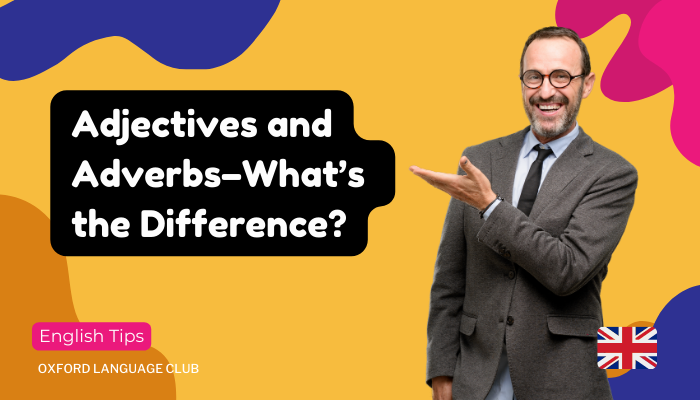


An adjective is a word that describes nouns, such as "large" or "beautiful", and an adverb is a word that describes verbs, adjectives, and other adverbs, such as "silently" or "really". That’s the basic difference between adjectives and adverbs, but there’s more to it than that: How can you tell them apart, how do you change them into each other, and which do you use with linking verbs?
Below, we answer the question: What’s the difference between an adjective and an adverb? We’ll discuss how and when to use each and share plenty of adjective and adverb examples.
What’s the difference between an adjective and an adverb?
Adjectives and adverbs are often confused in grammar because they’re both words that describe other words. The difference between adjectives and adverbs is which types of words they describe.
Adjectives describe only nouns, including pronouns. So if you have a noun like "dog", you can give more details about it by adding adjectives.
Sometimes multiple words work together to describe a noun. This is called an adjective phrase, and you can treat these groups of words the same as individual adjectives.
Adverbs commonly describe verbs. They add details to show how an action is done, as with the adverbs quickly or slowly, or the frequency of the action, as with the adverbs often or sometimes.
Additionally, special adverbs like really or very can also describe other adverbs. When adverbs are used like this, they usually describe the degree of intensity or frequency.
Likewise, adverbs can also describe adjectives, again typically specifying the degree of intensity or frequency.
In the last example, the adjective "large" describes the noun "man", and the adverb "very" describes the adjective "large". Similarly, the adverb "really" describes the adjective "small", which describes the noun chair.
The best way to tell the difference between an adjective and an adverb is to identify the word it describes. If the word being described is a noun, then it’s an adjective; if the word being described is a verb, adjective, or another adverb, then it’s an adverb.
Sometimes you can use a shortcut to tell the difference between adjectives and adverbs. If you see a word with –ly at the end, it’s usually an adverb.
Be careful, though, because this isn’t always true. For example, words like "curly", "elderly", "friendly", and "lovely" are all adjectives that end in –ly. However, most words ending in –ly are adverbs, and remembering this can help you distinguish between adjectives and adverbs that have the same root word.
The calm morning passed.
The morning calmly passed.
Adjective vs. adverb: linking verbs
When it comes to adjectives vs. adverbs, a lot of confusion comes from linking verbs. If you’re unfamiliar with linking verbs, they’re a type of verb that does not show an action but instead shares more details about the subject.
The most common verb, "be", is a linking verb. So when we say, “She is the mayor,” the noun mayor describes the subject, which is the pronoun she. Other common linking verbs are "become" and "seem" as well as sensory verbs like look, feel, and smell.
The problem with linking verbs is that sometimes they can use either adjectives or adverbs. A linking verb uses an adjective when it’s describing the subject and an adverb when it’s describing the action. This can easily lead to confusion, so you have to be careful about which one you use when you’re writing because it changes the meaning.
Let’s look at two examples, one with the adjective "bad" and the other with its adverb counterpart, "badly".
In this example, we use the adjective bad, so it describes the subject, the noun lizard. Here, the lizard has a bad odor, so don’t stick your nose too close to it!
In this example, we use the adverb "badly", so it describes the action, the verb "smell". Here, the lizard has trouble smelling; maybe it has a cold and its nose is stuffed up.
How to turn adjectives into adverbs
Because adjectives and adverbs are so closely related, some root words can be used for both. That makes it easy to turn some adjectives into adverbs and vice versa.
For many adjectives, all you have to do is add -ly to the end to make an adverb.
Adjective - Adverb
loud - loudly
perfect - perfectly
hopeful - hopefully
If the adjective ends in a –y, drop the –y and add –ily to make an adverb.
Adjective - Adverb
easy - easily
happy - happily
lucky - luckily
If the adjective ends in -tle or -ble, replace the –e with a –y to make an adverb.
Adjective - Adverb
gentle - gently
comfortable - comfortably
terrible - terribly
If the adjective ends in –ic, add -ally to make an adverb.
Adjective - Adverb
specific - specifically
tragic - tragically
energetic - energetically
However, keep in mind that not all adjectives follow these rules.
For starters, some words can be both adjectives and adverbs without changing anything. We discuss those in the next section.
Adjectives that end in –ly, like "silly", "ugly", or "friendly", don’t have acceptable adverb counterparts. You’d have to use a synonym or phrase the sentence a different way.
Incorrect Salvador introduced himself friendlily.
Correct Salvador introduced himself amicably.
Correct Salvador introduced himself in a friendly way.
Moreover, the common adjective "good" has an irregular adverb counterpart: "well". This can lead to some accidental mistakes, so always be aware of which type of word you’re describing.
Identical adjective and adverb examples
There’s another source of potential adjective vs. adverb confusion: Some words stay the same whether they’re used as an adjective or an adverb. It can be difficult to figure out how the words below are used, so pay special attention to the word they describe to determine whether they’re adjectives or adverbs.
March, 2023
Posted by Oxford Language Club






















